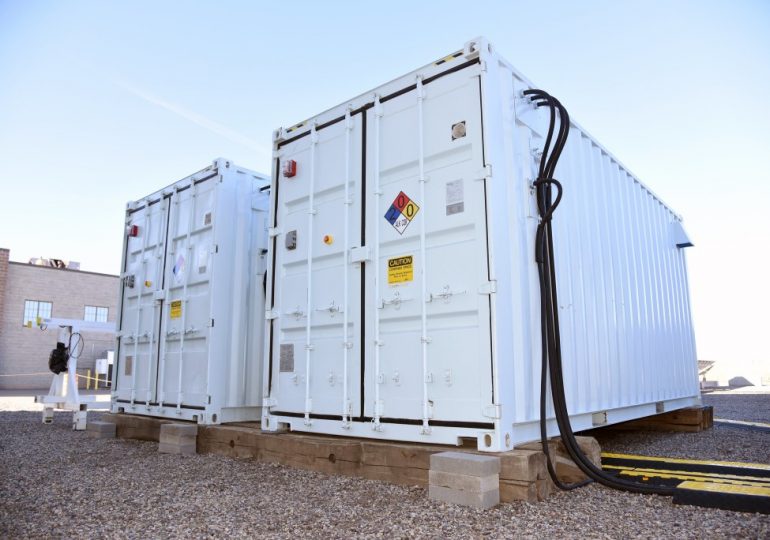The following commentary was written by Laura Sherman, president of the Michigan Energy Innovation Business Council. See our commentary guidelines for more information.
Last year, Michigan got attention as the first Midwestern state to adopt an energy storage standard. Energy storage is essential for the clean energy transition because it allows clean electricity initially generated by sources like wind and solar to be available at all times.
The standard calls for 2,500 MW of energy storage to be deployed by 2030. This storage will be fulfilled by a range of technologies, with lithium-ion batteries, the type of the storage that has grown rapidly across the U.S. and the world in recent years, chief among them. But it’s not too early to start thinking about how this standard (and future standards) will also involve new technologies that serve different needs, including shifting low-cost energy over longer periods of time to support electric reliability and affordability. A U.S. Department of Energy report found that to achieve a net-zero economy, the U.S. grid may need 225 GW to 460 GW of long-duration energy storage by 2050. By comparison, the U.S. currently has over 500 GW of gas power plants, and battery storage capacity is expected to double to about 30 GW by the end of this year, according to the U.S. Energy Information Administration.
Fortunately, Michigan’s energy legislation anticipated this need. The legislation that created the 2030 storage target also ordered Michigan regulators to report to lawmakers on the potential for long-duration and multi-day energy storage. The Michigan Public Service Commission (MPSC) is in the midst of this study right now.
But how is “long-duration” energy storage different from the battery storage that is growing quickly in Michigan and across the country right now? It’s all about the concept of duration, which refers to how long a storage resource like a battery can discharge stored energy until it is out of capacity. Most of the batteries being built at utility scale right now have a duration of around four hours. But long-duration storage refers to resources that have a duration of over 8 hours and up to well over 100 hours.
This longer duration unlocks capabilities that will make 100% clean electricity a reality. Short-duration storage right now can cover shortfalls in wind and solar on an hour-by-hour basis. But what about if there is a shortfall in energy supply expected not for just a few hours, but from one day to the next? Or from one month to the next? Those situations arise especially in seasons like winter, where cloud cover can linger and hamper solar energy production for extended periods of time. That is where the need for long-duration storage comes in. Long-duration storage could become a capacity resource that grid operators can tap to reliably deal with long-term fluctuations in energy supply, like those caused by changes in the season from summer to winter.
What would this type of energy storage actually look like in practice? Two companies that are members of the Michigan Energy Innovation Business Council are potential examples.
Energy Dome’s above ground compressed gas technology, the “CO2 Battery,” is a closed-loop system that holds carbon dioxide gas in a large dome structure. Using electricity from solar panels and wind turbines, this gas is heated and compressed into a liquid, which can be easily stored at room temperature. When discharging, the liquid is evaporated, and the resulting gas spins a turbine, generating electricity when needed, often with one full cycle per day (8+ hours of discharging). The company is currently constructing its first full-scale plant in Sardinia, Italy, with the project nearing completion. In the U.S., another plant is soon to follow, with project proponent Alliant Energy recently filing for regulatory approval of the Columbia Energy Storage Project in Wisconsin.
Form Energy is commercializing a multi-day energy storage technology, a 100-hour duration iron-air battery for utility-scale applications. Essentially, the battery rusts and un-rusts iron to store and release electricity. Form Energy has constructed a new factory to manufacture these batteries domestically, and is working to deploy the first large-scale demonstrations of its technology with utilities like Great River Energy, Xcel Energy, Dominion and Georgia Power in 2025 and 2026.
A tremendous amount of innovative work will need to happen between now and the realization of the full potential for long-duration storage. There are a few things Michigan regulators should do with their study to best set up the state to reap the benefits from these emerging technologies:
First, the Commission should set clear targets for how much long-duration and multi-day storage utilities need to procure in coming years. Utilities are generally conservative and hesitant to pursue new technologies unless pushed or clearly allowed. But this problem is particularly heightened when it comes to long-duration storage. That’s because utilities, if given a megawatt target for storage they must deploy, will likely acquire storage without considering the benefits of having a diverse portfolio of technologies that can deliver energy over different durations. As a result, Michigan may lose out on the operational benefits that come from having a diversified storage portfolio. These benefits include the ability of long-duration storage to make firing up high-emitting, fossil-fuel-burning peaker plants unnecessary because the storage can provide more reliable, cleaner and cheaper alternatives. They also include overall cost and land-use savings, by storing renewable energy when it would otherwise be wasted and shifting it over long time periods when it is most needed.
Second, speaking of substitutes for fossil fuel plants, the Commission should identify which power plant sites around the state could be good candidates for being replaced with long-duration storage projects. Michigan’s coal-fired power plants are almost all retired, with Consumers Energy this year set to retire its final coal plant in Ottawa County. Long-duration storage could be fitting replacements for not only those plants, but also gas plants that will be reaching the end of their life cycles in coming years.
With its storage targets, Michigan has already become one of the national leaders in energy storage. Let’s further cement that reputation by taking steps now for smart planning for long-duration storage. All Michiganders stand to benefit from the potential for long-duration storage to enable an electric grid that is cleaner, lower-cost and more reliable.
Commentary: How Michigan regulators can help advance energy storage is an article from Energy News Network, a nonprofit news service covering the clean energy transition. If you would like to support us please make a donation.
Leave a comment






